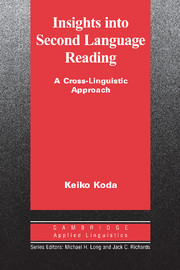12 - Comprehension instruction
Published online by Cambridge University Press: 05 October 2012
Summary
The intent of the closing chapter is to provide overall summaries of comprehension research, and, in the process, discuss key considerations in drawing functional implications for L2 reading instruction. The hope is that, through insightful analyses and rational speculations, it should be possible to flesh out far better ways of consolidating theory and practice.
What we know about comprehension
As has been evident throughout this volume, decades of effort to uncloak the mysteries of comprehension have yielded massive amounts of information. Our only recourse would be to plow through the data stockpiles one by one. To clarify matters so as to extract significant insights that may improve the ways we go about instruction, the following sections point up major research findings directly relevant to comprehension enhancement.
Decoding
As repeatedly noted, comprehension is a meaning-construction process, involving integral interaction between text and reader. Extracting phonological information from individual words constitutes one of the first and most important steps in this endeavor. The ability is critical because most words in beginning reader texts already are in children's oral vocabulary, and therefore usable phonological information mediates access to meanings not yet familiar in their visual forms. However, what matters most in learning to read is the child's emerging conception of how print relates to speech, because it conveys regularities in the writing system, however reliable, in mapping phonological information onto graphic symbols. Such sensitivity enables children to read new words through analogy and inference rather than by rote memory, thus promoting analytic approaches to word learning and processing.
- Type
- Chapter
- Information
- Insights into Second Language ReadingA Cross-Linguistic Approach, pp. 254 - 274Publisher: Cambridge University PressPrint publication year: 2005



